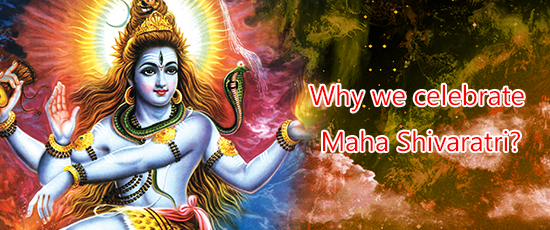Why we Celebrate Maha Sivaratri
Maha Shivaratri is celebrated across India and also in Nepal, Sri Lanka and Mauritius with lot of devotion, fanfare and enthusiasm. In 2018, Shivaratri is on 13th of February, the 14th night before New Moon.
Shiva according to Hinduism:
On Shivaratri, Shiva is worshipped in the form of a Linga, the formless Supreme God who represents the beginning and the end of all creations. Hinduism beholds a pagan religion that represents myriads of deities for each aspect of life and varied emotions of people. Out of this multiplicity of Gods, the Hindu Trinity of Brahma, Vishnu and Shiva emerges at the highest forms of manifestation of forces of the Universe. Here, Brahma depicts the creator, Vishnu, the administrator and Shiva, the destroyer. Despite this general categorization, lord Shiva is believed to be the cosmic male force encompassing all the three attributes: the creator, maintainer and destroyer of Universe. At the highest level of perception, He manifests as the force of evolution that activates the process of destruction to herald the recreation of our world ushering change in the existing Nature or System of Nature.
Shiva worshipped by his devotees:
Devotees of Shiva worship him after fasting the whole day. The hours of night on this day is considered perfect time to worship Shiva. Devotees chant the mantra ‘Om Namah Siva’ and perform the ritual of bathing (abhisekam) the linga with milk, honey and rose water or holy water of the Ganges. Thereafter, fruits, Bilva leaves and flowers are offered to him. This ritual is performed every three hours throughout the night. The ardent devotees of Shiva undertake pilgrimage to the prominent Shiva temples to worship him. There are ascetics who worship Shiva in Aghora form, and lead life as incarnation of Shiva, their body smeared with ashes, they renounce comforts of their family life and lead life of wanderers. Such devotees or sadhus, on this day, tend to go amok, chanting aloud mantra for lord Shiva, displaying their detachment from all earthly disciplines.
Other forms of Shiva worshipped as deity:
Lord Shiva is worshipped as Nataraja, performing the cosmic tandava dance, as Dakshinamurthy, a teacher imparting knowledge, Kala-Bhairava, the God of time, and Ardhanariswar, the combination of the male and female energies.
In Hindu religion, Shiva is perceived and realized in varied forms:
Shiva as Absolute and timeless Truth:
He is the ultimate reality, the Brahman. At the highest level of realization, Shiva is the formless reality that transcends all earthly orders. So he is the Nirguna Brahman.
Shiva as the Creator:
He is the Consciousness behind creation. He is the Cosmic male who unites with the Cosmic female, Parvati or Prakriti to create the material Universe.
Shiva as the Destroyer:
He is the destroyer of all negative forces that accumulate over periods of time and is responsible for recreation or regeneration of new consciousness. The process of evolution begins and ends with him.
Shiva as the Enlightened self or the Liberator:
Shiva is also perceived as the realization of the ultimate truth of this Universe. He is the link between the Earth and the Universe, so by realizing Shiva through meditation one can triumph over pain and imperfections of life and gain the knowledge of ultimate truth. He crushes the Ego that arises from ignorance, or false knowledge of reality and liberates the soul where it can be one with the energies of the Universe. He brings Salvation.
Shiva as the Boon-giver:
Shiva is worshipped as deity who is full of grace and protects his ardent devotees who understands him and embeds him in their realization of truth.





















